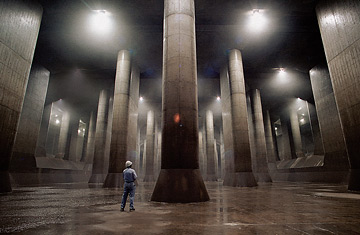
A worker stands inside the water pressure control pool in the G-Cans Project, one of the worlds largest underground river construction projects, in the eastern part of Saitama prefecture, Japan.
(3 of 3)
The Army Corps of Engineers and the government of Louisiana are each preparing plans for flood defense and coastal restoration. But after the Corps's disastrous performance during Katrina, many locals distrust it. The state worries that the Corps, despite reassurances from the director of its civil-works division, will shortchange wetlands protection in favor of its traditional preference for large levees. "We're not going to let them go down that road," says Robert Twilley, chief scientific adviser to the state's planners. "If we don't restore our wetlands, the levees won't last and neither will our economy."
In Louisiana, as elsewhere, smart adaptation requires a lot more than good infrastructure and ecosystem management. Economic viability is also important, and that is not possible without insurance. In Louisiana and Florida, insurance companies responded to the burst of hurricanes in 2004 and 2005 by raising rates significantly, even canceling policies outright. How can hurricane-prone states retain coverage? "The only solution is to get the Federal Government to do what it did after September 11 and recognize that some risks are too large and costly for the private-insurance market to absorb on its own," says James Donelon, the state insurance commissioner of Louisiana. The Terrorism Re-Insurance Act of 2002 made $100 billion in federal money available as a backstop for buildings vulnerable to terrorism. Donelon advocates a similar fund for cities threatened by climate change.
The U.S. has a long way to go before it is climateproof, but so does most of the world. Japan has an impressive, long-standing system of flood control, including the so-called G-Cans project, a massive underground system in Tokyo that can pump 200 tons of water per second out of rivers and into the harbor before the city's streets flood. But former city officials acknowledge that Tokyo's system has reached its capacity. Since global warming is expected to bring Japan more frequent torrential rains, Tokyo will have to upgrade its drainage and sewage systems.
The latest science makes it clear that we will be living with global warming for the rest of our lives. That's not a happy thought, but it's not necessarily dire either. The key is to follow the new rules of life under global warming. Think ahead, adapt as necessary and make sure to cut greenhouse emissions in time. Adaptation won't be cheap. It won't be optional either.
Mark Hertsgaard is the author of Living Through the Storm: Our Future Under Global Warming, forthcoming from Houghton Mifflin Treating the First Casualty More than a century of efforts to protect New Orleans from flooding has left the city more vulnerable than ever. The coastline is shattered, and the land is sinking. Proposals for saving southern Louisiana could become a laboratory for U.S. coastal cities threatened by rising seas and stronger storms. [This article consists of a complex diagram. Please see hardcopy of magazine.] THINKING BIG Protecting New Orleans means putting more of everything between the city and the sea. Planners have three main ways to do that: 1 ENHANCE BARRIER ISLANDS Katrina devastated the already withered outer defenses. As the islands shrink, waves reach farther inland 2 RESTORE WETLANDS Walls and channels along the rivers prevent silt from replenishing marshy areas, which can sponge up floodwaters 3 BUILD FLOODGATES AND LEVEES An inner line of gates like this one in the Netherlands could protect the city from storm surges
